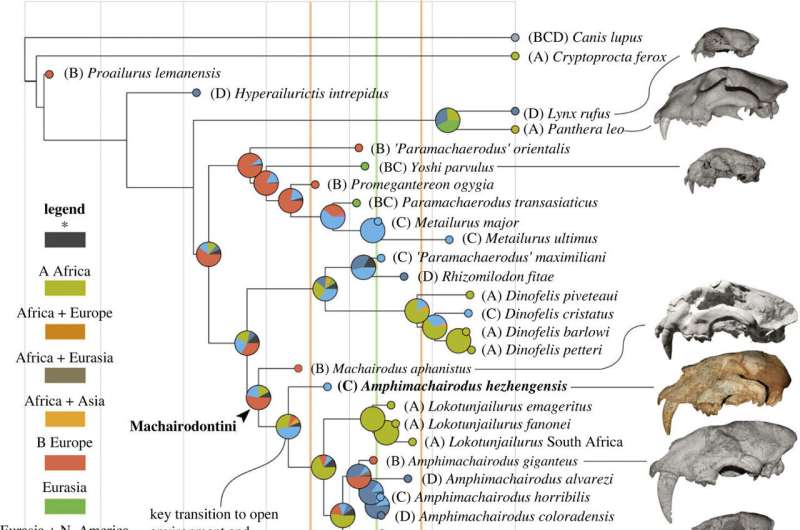April 20, 2023 report
This article has been reviewed according to Science X's editorial process and policies. Editors have highlighted the following attributes while ensuring the content's credibility:
fact-checked
peer-reviewed publication
trusted source
proofread
Trait adaptations in a Tibetan saber-toothed cat

Published in the Proceedings of the Royal Society B, a new study details unique findings, analysis and interpretation of saber-toothed cat fossils, offering a glimpse into how the fierce apex predators operated on the high plains of its native environment.
If familiar with images of the saber-toothed cat of the Americas, Smilodon, a mental picture of a large cat with long, slightly curved protruding canine teeth, will come to mind. The Tibetan find, Amphimachairodus hezhengensis, is a distant cousin of Smilodon (common ancestor 16 million years ago) with much shorter canines and a more elongated face closer to a lion than a panther in appearance. Saber-toothed cats split off from all other forms of cats (including lions, tigers and domestic cats) around 18 million years ago.
The study specimen is a nearly complete skull discovered previously in the Linxia Basin, dating to around 8.7 to 9.8 million years old. The age makes it the earliest member of the Amphimachairodus genus found in the region and gave researchers a glimpse into the lineage's evolution based on its morphology and adaptions.
The long snout with the laterally oriented and posteriorly located eyes of A. hezhengensis (like a lion) suggests to the researchers an advantage in observing a surrounding environment rather than targeting single prey, pointing to an adaptation to an open environment.
Analyses of trait evolutionary rates support the development of features related to killing behavior and open environment adaptation evolving before other traits, meaning that changes in hunting behavior were likely major evolutionary drivers in the early evolution of the saber-toothed lineage.
This earliest example of the Amphimachairodus line shows a marked departure from ancestral morphologies. This rapid morphological change is likely correlated with increasingly arid and open environments caused by the rise of the Tibetan Plateau, which transformed the regional fauna and brought in competition from large carnivores.
The most abundant competition for prey was a giant hyena (Dinocrocuta gigantea) found throughout the site excavation, a well known open plains hunter that reinforces the picture of the A. hezhengensis open environment.
A previously discovered forepaw, thought to be found in the same area, showed signs of injury and healing. This implies that A. hezhengensis was part of a pride (assuming that is the nomenclature for a group of saber-toothed cats) with community members hunting and allowing meals to be shared.
The lead researcher on the study, Qigao Jiangzuo, just last year described the smallest saber-toothed cat ever discovered.
More information: Qigao Jiangzuo et al, Origin of adaptations to open environments and social behaviour in sabretoothed cats from the northeastern border of the Tibetan Plateau, Proceedings of the Royal Society B: Biological Sciences (2023). DOI: 10.1098/rspb.2023.0019
Journal information: Proceedings of the Royal Society B
© 2023 Science X Network





















